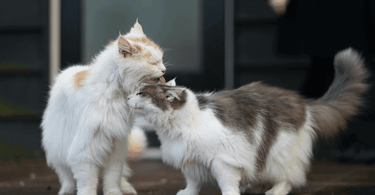By Francesca Lees BSc (Hons) NCert (AnBeh) ISFM Cert FN RVN
If you’re a cat lover you may share your home with multiple cats. In fact, we are such cat lovers in the UK that households that have cats have an average of 1.6 cats.
It may seem like a great idea adding another cat to your household, but you do need to consider the impact of a new cat on your existing cat or cats. In this article we will look at why cats can sometimes struggle when living with other cats and how you can create a safe and happy environment so that your cats can thrive whilst living together.
The history of the domestic cat
Firstly, it's important to note that our domestic cats, although very cute and well adapted to being family pets, are still very closely related to their wild counterparts. The domestic cat (Felis Catus) is thought to have mainly descended from the African wild cat (Felis Sylvestris lybica) and since then they haven’t really evolved much at all.
Unlike dogs, cats haven’t really changed in terms of the way they behave and even through domestication our domestic cats still act and behave in a very similar way to their wild counterparts. By retaining many of these characteristics domestic cats are therefore able to live without humans and can survive without any human intervention, unlike dogs who now are much more reliant on humans to survive.
Genetic testing has shown that our domestic cats share almost identical DNA to that of the African wildcat! Because of this domestic cats still feel an innate desire to do much of their activities how they would do in the wild...alone. In the wild cats are solitary hunters and they prefer to hunt, eat, toilet and sleep in solace. They are also very territorial and are very particular about their territory and how they perceive their territory within the environment where they live. This can therefore prove to be a problem for cats who are made to live together.
Will kittens always get along?
It is known that kittens who come from the same litter and are brought home to their place of residence together are much more likely to grow up bonded and happy living under the same roof. If you are thinking of getting a cat and you would like more than one cat in the future then the ideal situation would be to get two kittens from the same litter. However, if you already have one kitten and are thinking of adding another cat to your family home at some point the general guidance is to do this before your kitten reaches a year old. Cats are much more likely to accept a second cat whilst they’re still young, however it is not always successful.
Behaviours you may see in a multi-cat household
Cats who have been with their other housemates from an early age and who are bonded with their fellow felines are more likely to show displays of allogrooming (when cats groom each other in an affectionate way) and will happily sleep together, curl up together, they will share beds and furniture and share food bowls and litter trays. Cats who are not bonded will often avoid sharing any resources and will often become very stressed if they are forced to share resources. Sometimes you may notice two cats sitting on the same sofa and think that they must like each other if they’re doing so, however it’s important to remember that if both cats want to sit on the sofa and their desire to be comfy is so strong that they must share it with another cat (even one they’re not bonded with) they will then still sit on that sofa. You may notice they don’t sit close and they often sit at other ends of the sofa.
Sometimes this can then cause them to feel stressed as they would really prefer to have the sofa to themselves but they have no choice but to tolerate the other cat who is also sitting on the sofa.
How can you create a stress free and happy environment for cats who live together and who are not bonded?
It is possible to create a multi cat friendly household and by doing some simple things to their environment you can really help your cats to cope better when they live together.
Increase resources available to your cat
Generally cats who show tension between each other within the home are struggling with sharing resources. So the first thing you can do is make sure all of the cats within your home have enough resources so that they do not need to share. Make sure to provide each cat with their own food bowl, water source, scratch post, bed and litter tray.
Provide high vantage points for your cats to climb up
If your cats have somewhere within the home that they can do this it can help cats who are not bonded to be able to observe other cats in the home and see what they’re up to whilst knowing they are nice and safe up high.
Cats like to feel in control of any situations that may arise and being up high gives them this sense of control. You can just clear some window sills or tops of cabinets or you can install some specially designed cat shelves for them to perch on like these.
What should I do if there is tension between my cats?
- If you have a multi cat household and there is tension between the cats it is really important to remember not to punish any of the cats for fighting. Cats should not be sprayed with water, told off or physically reprimanded as they are just instinctively being a cat. Using punishment will only make the cats more stressed and could cause them to be fearful and anxious of you, breaking the bond between you. If you need to break up a fight between two cats then try grabbing a towel and throwing it over one of the cats and scooping them up in the towel and taking them into a separate room to calm down. Keep the cats separated for a short period to cool off before letting them back in together.
- Try using a pheromone plug in such as Feliway Friends or Feliway Optimum. These plug-ins are designed to give off some of the “happy hormone” that cats emit when they are happy and so can help cats to tolerate each other better.
- Try “scent swapping”. Cats are heavily reliant on scent to help them navigate their world and they will often use scent markers and sniffing to help them build a picture of their environment and their territory. You can help your cats to accept each other better by doing something called “scent swapping”. This is when you rub something like a cloth or blanket around your cat's facial glands to collect some of their scent. You can then present this to the other cat and leave it for them to sniff, or you can wipe the scent onto objects within the home like beds, table legs, scratching posts, cat trees etc. This works particularly well when introducing a new cat into the home with an existing cat.
- If one of your cats needs to go to the vets ask your vet if you can bring the other cat/cats. If you take one cat to the vets on their own often when they return the other cat/cats within the home may reject them. This is due to the fact that the visit to the vets will have changed the scent profile of this cat and so when they return home they smell unfamiliar to the other cats and often the other cats cannot recognise them. Most vets are very accommodating and are happy for you to bring the other cat/cats with you. If your cat needs to stay at the vets within the hospital this is particularly important so always try and find a vet who will allow you to do this.
- Some vets are accredited as Cat Friendly Clinics by International Cat Care. These veterinary practices are very feline savvy and are usually very accommodating for cats needs. You can find an accredited Cat Friendly Clinic near to you by clicking here and typing in your postcode
If you are really struggling with tension between cats within a multi cat household you can always contact a Feline Behaviourist for a consultation. The ABTC has a register of accredited Clinical Animal Behaviourists who can help you with your cat's behaviour. Most pet insurance companies will reimburse expenses for registered cat behaviourists so getting help may be easier than you think.
Get 10% off your first order when you subscribe to our newsletter.

